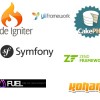Options for Publishing Newsletters
There are two ways of publishing your own newsletter – web based and script based. Both have their own benefits, but web based options can become costly if you have a large subscriber base.
One of the top web-based mailing list solutions, especially to designers, is Campaign Monitor. I had the chance to play around with CM for a little bit during the initial development period of Devlounge last January. We had a launch feed which was running on CM, but it wasn’t long before we did away with it. The service was very nice and easy to operate it use, but we just couldn’t justify paying to send out emails when we had so few subscribers. CM isn’t heavily priced either – you only pay when you send out emails at a rate of $5 plus 1 cent per recipient.
Other web-based mailing list services include Emma, Sparkit, Intellicontact, and Constant Contact.
For those that would rather would rather house their own script and have complete control over their mailing lists, there are many scripts written in various different languages that range free completely free to paid.
Some of my favorites include poMMo, an open source php mailing script and WebInsta (which was previously in use here). Both are free and allow complete control over newsletter design using template systems.
For those wanting to deliver instant content to their visitors, both Feedburner’s Feed flare and Zookoda offer your visitors newsletter with content pulled from your sites feed(s). Both these services also free. Zookoda gives you full ability of template customization, while Feed flare customization is limited.
But Wait, Do I Need One?
Anyone can have a newsletter, regardless of what type of site your running, or if you even run a site at all. Designers have newsletters to showcase new work to potential and previous clients. Companies use newsletters to showcase new and on sale products, and of course, new web startups use them to get the word out about launches, betas, and etc.
The question is not really do you need one, but will it benefit your visitors and if so, how? In the case of a designer, the more work potential clients see, the higher the chance they’ll hire you to do work for them. In the case of companies, its always good to advertise sales and fresh products, because it helps get the potential buyer interested, which can lead to valuable sales.
Don’t just have a newsletter simply for the sake of having one though, because you’ll find few visitors subscribing. Try offering special “Subscriber Only” content or offers, like many companies due to get your email address in their subscriber databases.
Daily, Weekly, Monthly, or what?
Before opening up that ever precise newsletter to your visitors, pick a delivery schedule that you can stick too. Just like the newspaper, you have to decide what delivery rate would best compliment your site. If you’re pushing out loads of new content each day that you want to spotlight, daily would be good for you, but if you post a few things here and there each month and just want to drop your visitors and update every few weeks, stick with monthly or semi-annual.
Another thing to keep in mind is getting at your subscribers quickly. Almost every service or script allows you to customize the “New Subscriber” and “Unsubscribe” email visitors get. Don’t just let these emails go ignored and left with default design and content simply because the user is either not fully subscribed yet or they’re dropping themselves off your list. Keep them interested by customizing these elements as you did with the rest of the newsletter.
No matter how frequently you plan on mailing your subscribers, make sure they’re getting updates in a customized newsletter that looks good and reads easily. New web application creators take note: Don’t just inform us when the product launches or hits public betas, but inform us with the current development status from time to time so we know the product isn’t dead. Now get out there and start sending.
